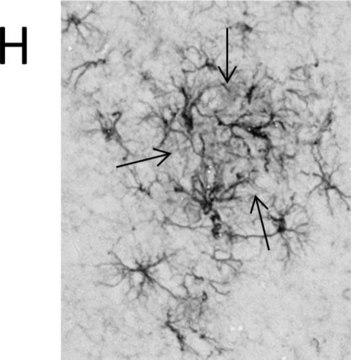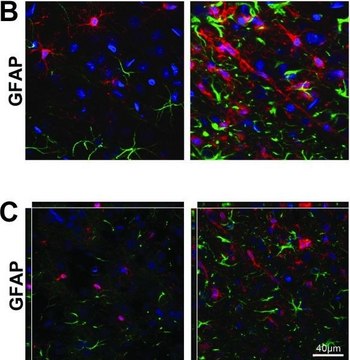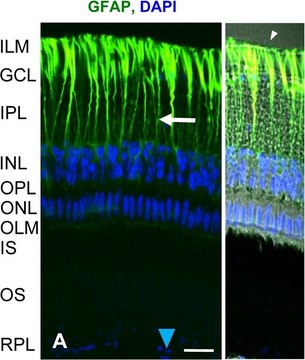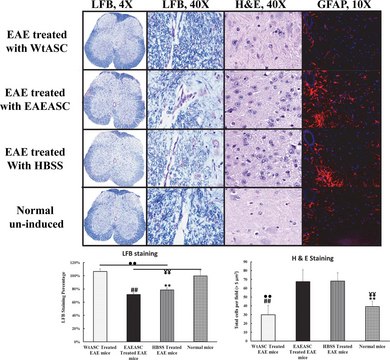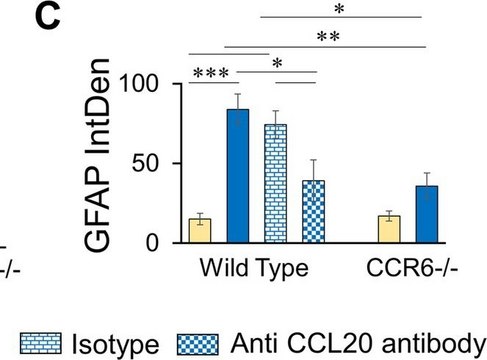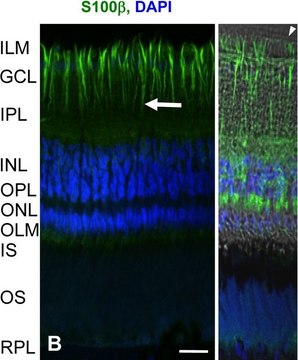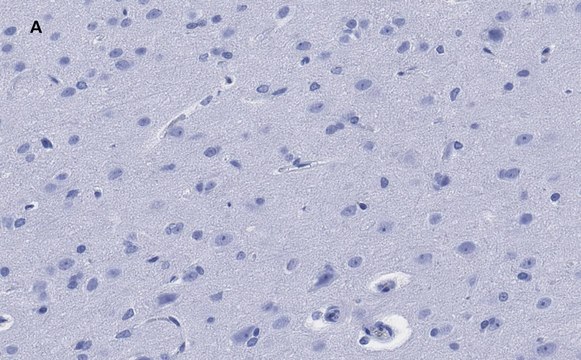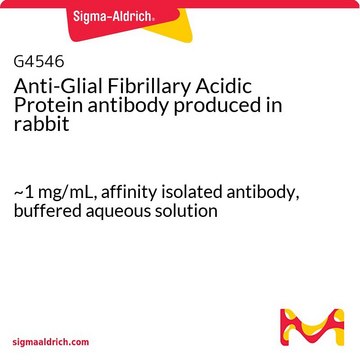推荐产品
产品名称
抗胶质纤维酸性蛋白 兔抗, IgG fraction of antiserum, buffered aqueous solution
生物来源
rabbit
质量水平
偶联物
unconjugated
抗体形式
IgG fraction of antiserum
抗体产品类型
primary antibodies
克隆
polyclonal
表单
buffered aqueous solution
种属反应性
rat, human
包装
antibody small pack of 25 μL
技术
immunohistochemistry (formalin-fixed, paraffin-embedded sections): 1:80 using brain sections
microarray: suitable
western blot: 1:500 using brain extract
UniProt登记号
运输
dry ice
储存温度
−20°C
靶向翻译后修饰
unmodified
基因信息
human ... GFAP(2670)
rat ... Gfap(24387)
一般描述
GFAP(神经胶质纤维酸性蛋白)基因编码一种中间蛋白纤维-III(50kDa)。它分别位于中枢和外周神经系统的星形胶质细胞和非髓鞘雪旺氏细胞。
特异性
该产物与 GFAP 特异性反应,并在免疫组织化学染色中标记星形胶质细胞,神经胶质细胞和胶质细胞衍生的肿瘤。该抗体在酒精或福尔马林固定、石蜡包埋的人或动物组织切片中与神经胶质特异性抗原反应。
免疫原
来自人类大脑的 GFAP
应用
兔抗胶质纤维酸性蛋白抗体适用于:
- 使用大鼠脑切片进行 1:400 工作稀释度的免疫组织化学染色
- 人脑肿瘤组织标本免疫组织化学染色鉴定表达 AQP4 (Aquaporin-4) 的细胞
- 使用小鼠脑切片的免疫荧光法
生化/生理作用
神经胶质纤维酸性蛋白在中枢神经系统发育过程中可用作区分星形胶质细胞与其他神经胶质细胞的标记物。GFAP负责维持胶质细胞的结构。它还为周围的神经元和血脑屏障提供机械强度和支持。该基因的缺陷会导致亚历山大病,表现为罗森塔尔纤维的沉积。它是罕见的中枢神经系统星形胶质细胞功能紊乱。GFAP表达增加表示星形胶质细胞增生,是神经退行性和神经炎症的病征。
外形
0.01 M 磷酸盐缓冲液 (pH 7.4) 中的溶液,含 15 mM 叠氮化钠
储存及稳定性
其在 2-8°C 条件下至多储存 1 个月。对于长期储存,溶液可以工作等份冷冻。不建议反复冻融或储存在“无霜”冰柜中。如果延长储存时间后出现轻微浑浊,使用前离心澄清。
免责声明
除非我们的产品目录或产品随附的其他公司文件中另有说明,否则我们的产品仅用于研究用途,不得用于任何其他目的,包括但不限于未经授权的商业用途、体外诊断用途、体外或体内治疗用途或任何类型的人类或动物消费或应用。
未找到合适的产品?
试试我们的产品选型工具.
储存分类代码
12 - Non Combustible Liquids
WGK
WGK 2
闪点(°F)
Not applicable
闪点(°C)
Not applicable
法规信息
常规特殊物品
从最新的版本中选择一种:
分析证书(COA)
Lot/Batch Number
Glial fibrillary acidic protein: from intermediate filament assembly and gliosis to neurobiomarker
Yang Z and Wang K K
Trends in Neurosciences, 38(6), 364-374 (2015)
Induction of glial fibrillary acidic protein expression in astrocytes by nitric oxide
Brahmachari S, et al.
The Journal of Neuroscience, 26(18), 4930-4939 (2006)
S Saadoun et al.
Journal of neurology, neurosurgery, and psychiatry, 72(2), 262-265 (2002-01-18)
Aquaporin-4 (AQP4) is a highly conserved water channel protein. In rats, AQP4 is expressed in astrocyte foot processes and is important in brain water homeostasis. AQP4 expression has not been investigated in non-neoplastic human brain or oedematous brain tumours, where
David Piccin et al.
Stem cells (Dayton, Ohio), 29(3), 528-538 (2011-03-23)
Neural stem cells comprise a small population of subependymal cells in the adult brain that divide asymmetrically under baseline conditions to maintain the stem cell pool and divide symmetrically in response to injury to increase their numbers. Using in vivo
Tomokatsu Yoshida et al.
Journal of human genetics, 58(9), 635-638 (2013-08-02)
Alexander disease (AxD) is a rare neurodegenerative disorder. Most patients with AxD have a de novo dominant missense mutation in the glial fibrillary acidic protein (GFAP) gene. Patients with late-onset AxD exhibit a more variable onset and severity than patients
我们的科学家团队拥有各种研究领域经验,包括生命科学、材料科学、化学合成、色谱、分析及许多其他领域.
联系技术服务部门